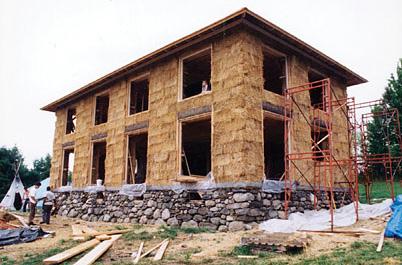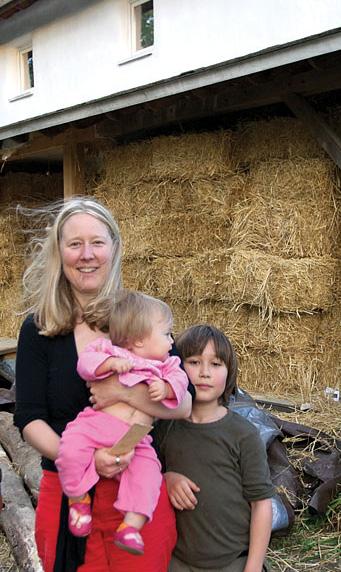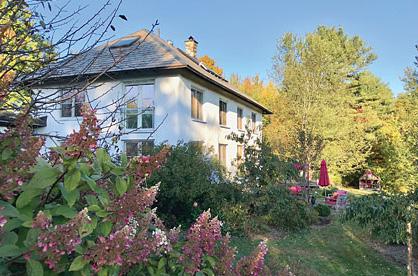
6 minute read
Earth Sweet Home by Juliet Cuming
Earth Sweet ome
BY JuLIET CuMING
Advertisement
In 1995 I moved to Vermont with my husband, pregnant with our first child. We were seeking to build a home, a home that neither of us had ever had.
We were both raised in New York City, by single parents in apartments, with infrequent access to plants, trees, wild animals, blue skies and all the things that childhood should be filled with.
We had survived our upbringings and were hell bent on doing things better. Present-day difficulties and intergenerational traumas continued to haunt us, but, being young, we filed the difficult stuff away for future reckoning. After a few years of searching, we made our way to Vermont, where we hoped to craft a new, better, healthier life for ourselves.
I knew that whatever was ailing me was not getting better in the toxic stew and screaming noise of the city. Just being out in the air, near trees and plants, allowed my nervous system, which was permanently turned up to 11, to relax.
In Vermont, living the life we craved felt easy. The week after we moved into the rental house we’d be living in while we built our green dream house, we attended a country fair where the electricity was provided by the solar folks who would be installing our photovoltaic panels. That same week, some building friends of ours from out West were holding a straw bale workshop at a local farm. The publication Environmental Building News, which we’d been avidly consulting, was located seven houses up the street from our rental. At my first midwife appointment, I discovered that my midwife lived, literally, in the house next door. The stars had aligned.
We, who had never owned anything, “bought” the land on which we planned to build our home a few weeks before we officially moved to

Vermont. It was Abenaki land, like all of southern Vermont. The idea of owning land seemed, and still seems, preposterous. I’m waiting to give the land back to some entity that makes more sense. In the meantime, I’m trying to do as little damage as possible: some permaculture near the house, the removal of a few trees and some invasive species, but otherwise letting things unfold, and leaving that all important biomass on the forest floor.
They say you should never live in a house you are in the process of building; they are right. It took seven years of madness to finish the house, and a couple more to realize we needed to do it again. We needed more space for our home based business, and for an aging parent, so in 2008 we built a second building: also straw bale, also local and all natural, also hand plastered and also off the grid. All of the same materials and practices that we’d used for our first building had worked so well, why mess with the recipe?
Back in 1995 we had created a set of ideals for ourselves: to build as people have traditionally built, to use only materials from within thirty miles of the building site, and to use only materials that will one day return to the soil whence they came. Considering that the average construction material travels thousands of miles, following our mandate forced us to interact with our community in ways that most people never do, and I certainly had never done before. In New York I did not know the person on the other side of my bedroom wall; in Vermont I became widely known, even to people I had never met before, as one of the “straw people.”

Of course there were certainly many items that we could not source from less than thirty miles away, but it was amazing to discover how much we could. We had our windows made by a carpenter who specialized in making replicas for historical buildings. All the wood for the timber frame and the outdoor stairs and decks came from nearby forests and was milled by a fellow who is too busy raising local beef to make lumber now, but we do chat whenever we meet, like two old grannies, about our hemlock timber frame and how it looks now. And the farmer who grew our straw for us — “You want the straw for what?” — grew both the 1996 batch and the 2008 batch, so even our straw bale walls are “related” to each other.
Speaking of the straw that makes our house so unique — it’s straw, not hay. And in case you think that I’m living in a haystack, you can’t see the straw unless you look at the secret “truth windows” where we left small areas of straw un-plastered so as to prove the truth to

naysayers. The fact is, the straw bales are hidden under layers of mud and lime plaster that have turned the thick, lumpy, furry enclosures that wrap around the timber frame into sleek organic sculptures that surround us in a soft undulating embrace.
The lime for our final coats of lime plaster came from a quarry a bit outside our range, in Lee, Massachusetts, but the mud for our initial coats of mud plaster came from literally under our feet, on the building site. Our dry-laid stone foundation was also home “grown,” from what old-timers call Vermont’s “most plentiful crop.”
Inside the house, we focused on being as nontoxic as possible, which meant no new stuff, only solid-quality old stuff that had already outgassed. We found sinks and bathtubs at various salvage places. Doors from an old hotel. At one point, every piece of furniture we had was from the side of the road or from family, and everything has a story.
In addition to our wish that the house be completely nontoxic and biodegradable, we also wanted to do something for sewage treatment that would put our “waste” to good use. We got a variance from the State of Vermont to put in a constructed wetland, as long as we also put in a small backup septic system. In twenty-five years, we’ve never used the backup system. Cattails and a variety of other plants suck up all the nutrients (aka pee and poop) out of the black and gray water, leaving the water that comes out of our constructed wetland to be drinking water quality, though to be honest, I’ve never drunk it.
I wish Vermont was still village based, but I’ve grown to love living out in the countryside. I’m more dependent on a vehicle than I would like, but every day I wake up here feels like a gift. Even now, after twenty-five years, I get so excited about the sparkling frost-covered branches glittering outside my windows, a magical surprise on a bone-chilling day. And what I smell and feel when I walk out my door when the moist green springtime arrives at last is something that no screen can ever capture.
My kids may not realize how much they know about natural building and salvaging and looking for local resources and saving electricity, but I think some green awareness is probably built into both of them, and hopefully they’ll bring it wherever they go and be part of the changes in how we think and live and consume and create. Both have loudly proclaimed that they never want to build a house, but I’ve caught my daughter working on floor plans, and my son is harboring an obscene number of books about architecture.
The marriage has not survived. Another COVID casualty. Even building a beautiful green home cannot cure trauma, unhealed grief, addiction, and the things that make people miserable. Eventually that stuff, no matter how carefully filed away, must be reckoned with.
But I’m still here and I don’t regret a single day that I spent building this wonderful all-natural home in this wonderful all-natural place.
Juliet Cuming is working on a book entitled Earth Sweet Home, about building one of the greenest homes in America. Learn more about her house at earthsweethome.com.










